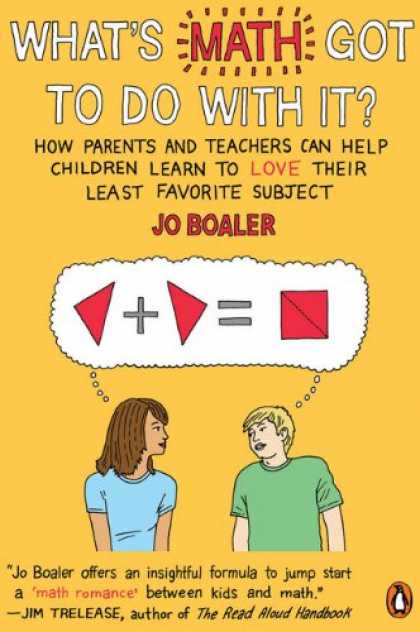This semester my preservice elementary class is reading Jo Boaler's What's Math Got to Do With It?
Today was the start, with them having read Chapters 1-3. Through experimentation I'm currently wanting groups from 5-8. (Haven't had a class of 9 students yet.) After group discussions, wwe have a couple minutes for groups to decide what they want to share or what was important, and then we have a whole class summary. Early on I randomly assign roles; later in the semester I let the groups choose.
- Leader - responsible for overall discussion, uninvolved group members, checking on other assigned roles.
- Questioner - if discussion stalls, posing a question
- Recorder - Keep notes on what is said
- Reporter - During whole class share responsible for representing their discussion.
Today they noticed:
- Get out of the rut of how you're thinking about teaching. Don't have to teach like you were taught.
- Old value of "If you don't know, then don't guess." vs how effective trial and error is as a problem solving method.
- Examples vs definitions. We know many more examples than definitions, but math can focus on definitions.
- Math of a daisy: never knew about that. what else has mathematical qualities that we've never thought about? Can math be integrated into other areas? Connections are intriguing. Engaging for students.
- Tradition vs technology: find a balance. Need tech, because of its power and today's learners' expectations, but not always, because... (need skills, too soft, ... never really finished the thought.)
- Math wars: parents going behind teachers' backs with little information.
- Liked the book: good information. Surprisingly light reading.
- Balance between drill and math literacy. Kids aren't comfortable with numbers/content; how do you get them comfortable with out drill and kill? Activities vs. practice.
- Why is math so awful in the US? Employment statistics on how many more careers need math than the number of people we're graduating with math competencies. How to interest students?

It made them think about or wonder:
- Communication with parents is crucial: newsletters. Include all subjects, optional activities, involve parents.
- Students teaching students in inquiry instruction.
- Not right way vs wrong way, instead get studetns aware of the many ways.
- Teach for understanding, not for practice.
- What age level is this for?
- How do you assess to find out who's falling through the cracks? Tests don't seem to always work.
- Why couldn't we do conferring like Lucy Calkins? Conferring. Could elementary students use portfolios like we use. Find their own problems. (This started a discussion of MAPS testing and running records and DiBELs...)
- When did we get scared of numbers? When did math become scary? How?
- Kids need some practice. But motivation matters. Rewards? Competition?
- Our experiences. If we had a question, the answer was often "look in your book." The teacher needs in depth understanding of the content to lead a discussion.
NEW 5/25: 2nd Edition of Book Club. Students had their choice of Ch. 4, 5, or 6, and everyone read Ch. 7.
Students noticed:
- Ch 4 - America overtests compared to other countries.
- Ch 5 - ability grouping negatively affects learning. Low self-esteem. So balanced teachig integrating students. Leads to labeling.
- Nonhomogenous groups see and share more strategies.
- Ch 6 - gender equality. Female understanding vs. male memorizing. Women can be more in depth learners.
- Connect with reading differences by gender.
- Questions. As they get older, students ask less questions. Making sense of problems. Incites thinking.
- Ch 7 - Key strategies. Lower achieving students focusing on procedures vs. concepts. Math builds, so this is dangerous. Connections make a knowledge cone.
- Example: Four strategies: counting together, counting on, known facts, derived facts
- Math can scar students.
- How to get parents involved? Newsletters, etc.
- How do they figure out who goes where? Important to mix gender in groups.
- Have to get students working with each other.
- How to keep higher achieving students from doing all the work? Stations, maybe, like in the Amazing Race. Not everyday, but occasionally to teach how to learn together. Everyone has to write. Assigned roles, that switch each time. (Science connection.)
- How to create a question friendly atmosphere? Maybe a question box. Open time for students to come ask questions (before, lunch, after school) Poker chips. Each gets two chips and they have to ask at least two each day. Emphasize questions are valuable. Teachers ask questions that students might have.
- Why give struggling students more practice? How is that supposed to help?
- Awesome to do fun stuff everyday, but exhausting. But on the other hand, you can do the same thing over and over until it's deadly boring. Cross curriculum helps. Make it memorable.
- Beware the rut of teaching and repeating what's not working.






No comments:
Post a Comment